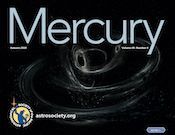Fall 2020 - Volume 49, Number 4

Table of Contents:
[19] Space News
A rundown of some of the most exciting developments in space and time.
[24] The Ripple Effect
The first five years of gravitational-wave observations have changed the field of astronomy.
[32] Seeing All the Colors of Gravity’s Rainbow
The next generations of gravitational-wave observatories will reveal more of the invisible cosmos than ever.
[38] The Dendera Zodiacs: A Rorschach Test
Many have tried to interpret the astronomical significance in these two Egyptian engravings of the cosmos.
Departments:
[3] Perspectives, Liz Kruesi
Looking Back, and Looking Ahead
[4] First Word, Linda Shore
Celebrating the Return of the Light
[6] Annals of Astronomy, Clifford J. Cunningham
Cicero and the Great Year
[8] Astronomer’s Notebook, Jennifer Birriel
Light Pollution, Satellites, and Variable Stars, Oh My
[11] Armchair Astrophysics, Christopher Wanjek
Spaghettification on the Menu
[13] Education Matters, Brian Kruse
The Immediacy of Data
[15] A Little Learning, C. Renée James & Scott T. Miller
Evidence of the Multiverse?
[43] Reflections, Liz Kruesi
25 Years of the Sun
************
The Ripple Effect (Feature)
By C. Renée James
Where do you see yourself in five years? It is a question painfully familiar to those with a long history of searching for gravitational waves, ripples in the fabric of space-time. After multiple five-year timespans of trying to detect gravitational waves, the upgraded Laser Interferometer Gravitational-wave Observatory (LIGO) made its first detection in September 2015. It’s been five years since that black-hole collision changed astronomy. And, as author C. Renée James writes, perhaps the most exciting aspect of the first five years of gravitational-wave observations — other the fact that we can actually make them at all — has been the unexpected results.
Seeing All the Colors of Gravity’s Rainbow
By Matthew R. Francis
Gravitational-wave astronomers have always looked to the future. The nature of gravitational-wave signals requires pushing technology to its limits if scientists have any hope of extracting any scientific information from them. From the moment LIGO and Virgo were first built, researchers planned how they would be upgraded to be more sensitive to faint signals, and they thought hard about what instruments would be necessary to detect currently unreachable sources.
The Dendera Zodiacs: A Rorschach Test
By Elisa Shoenberger
The circular Zodiac of Dendera hangs from the ceiling in a lesser-known gallery in the Louvre’s Egyptian galleries. It depicts a circular sky with planets, known constellations, and a panoply of ancient Egyptian mythological elements. Since the European’s discovery of the zodiac, scholars have tried to decipher its content and meaning, often creating theories not supported by historical or archaeological record. In the same temple that this circular zodiac was taken from still sits a rectangular zodiac engraving. Many have tried to interpret the astronomical significance in these two Egyptian engravings of the cosmos.
